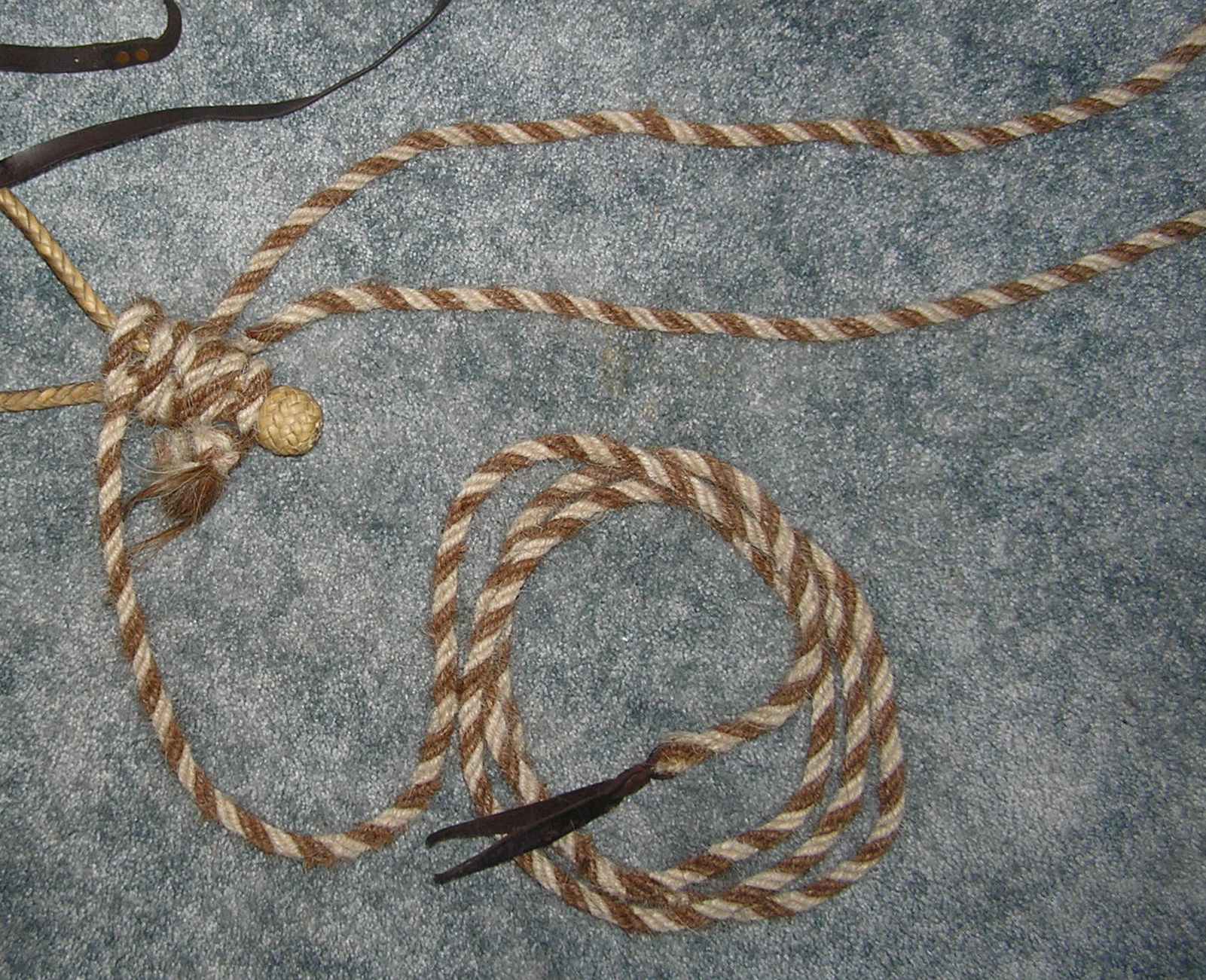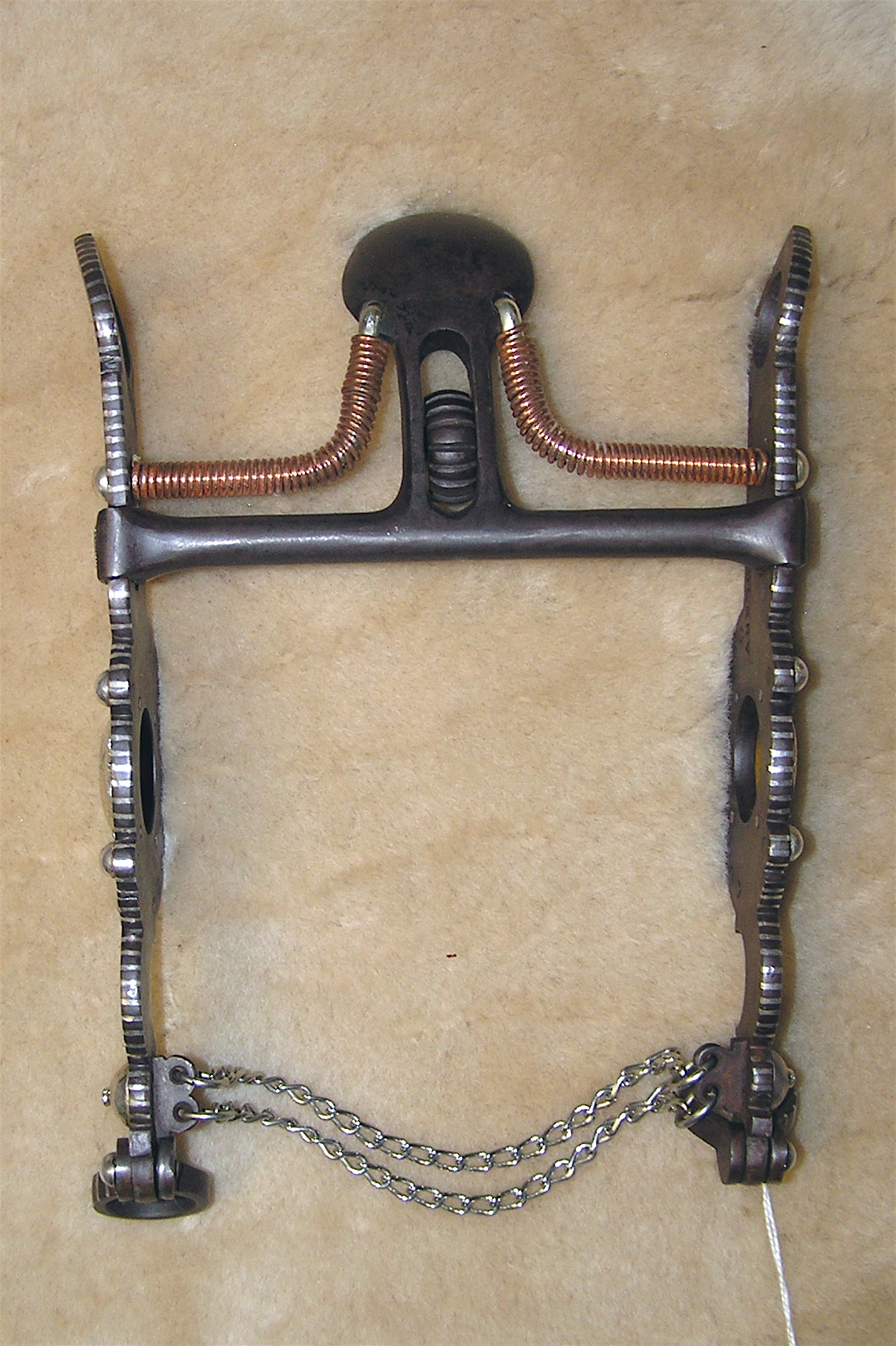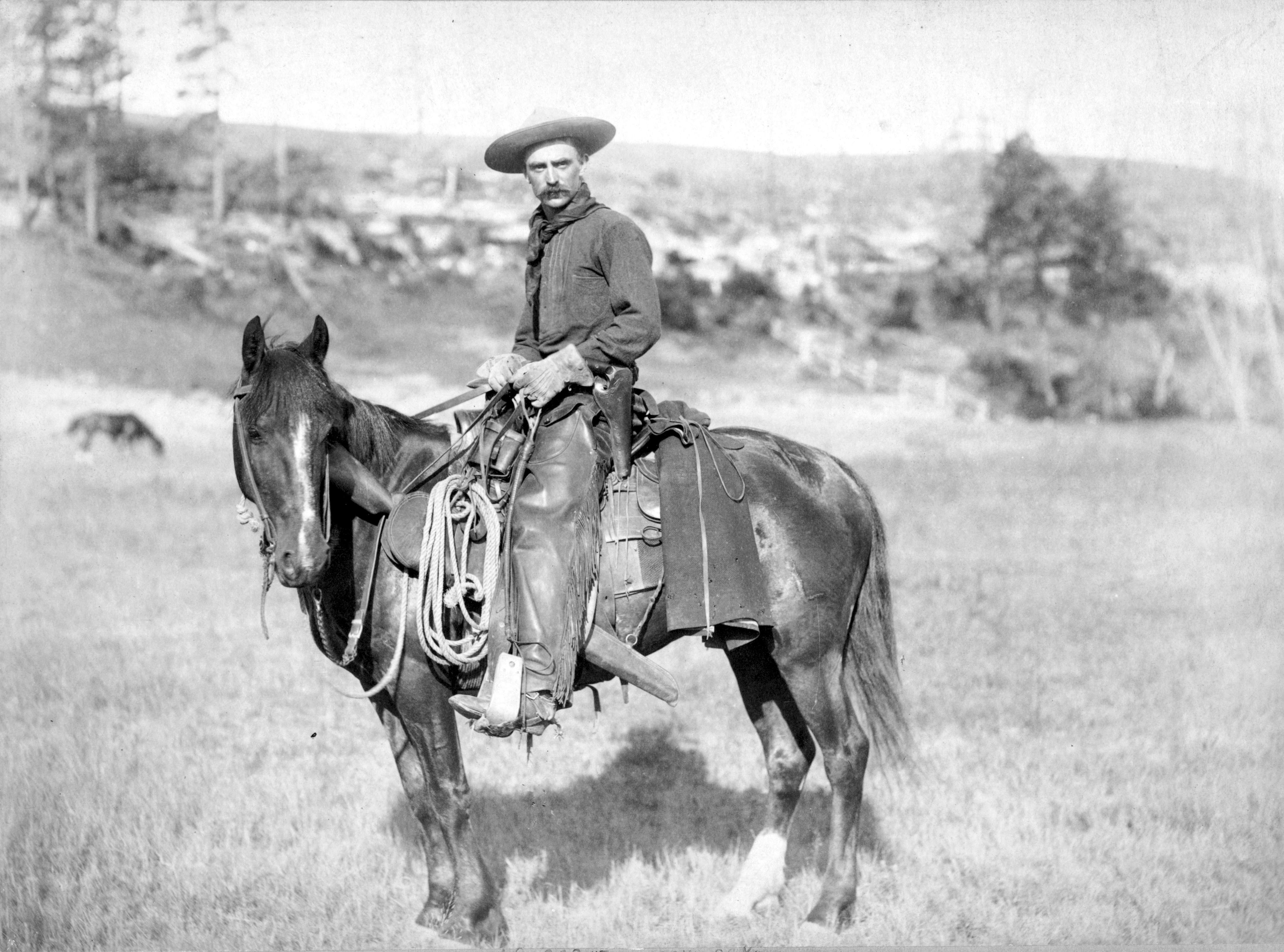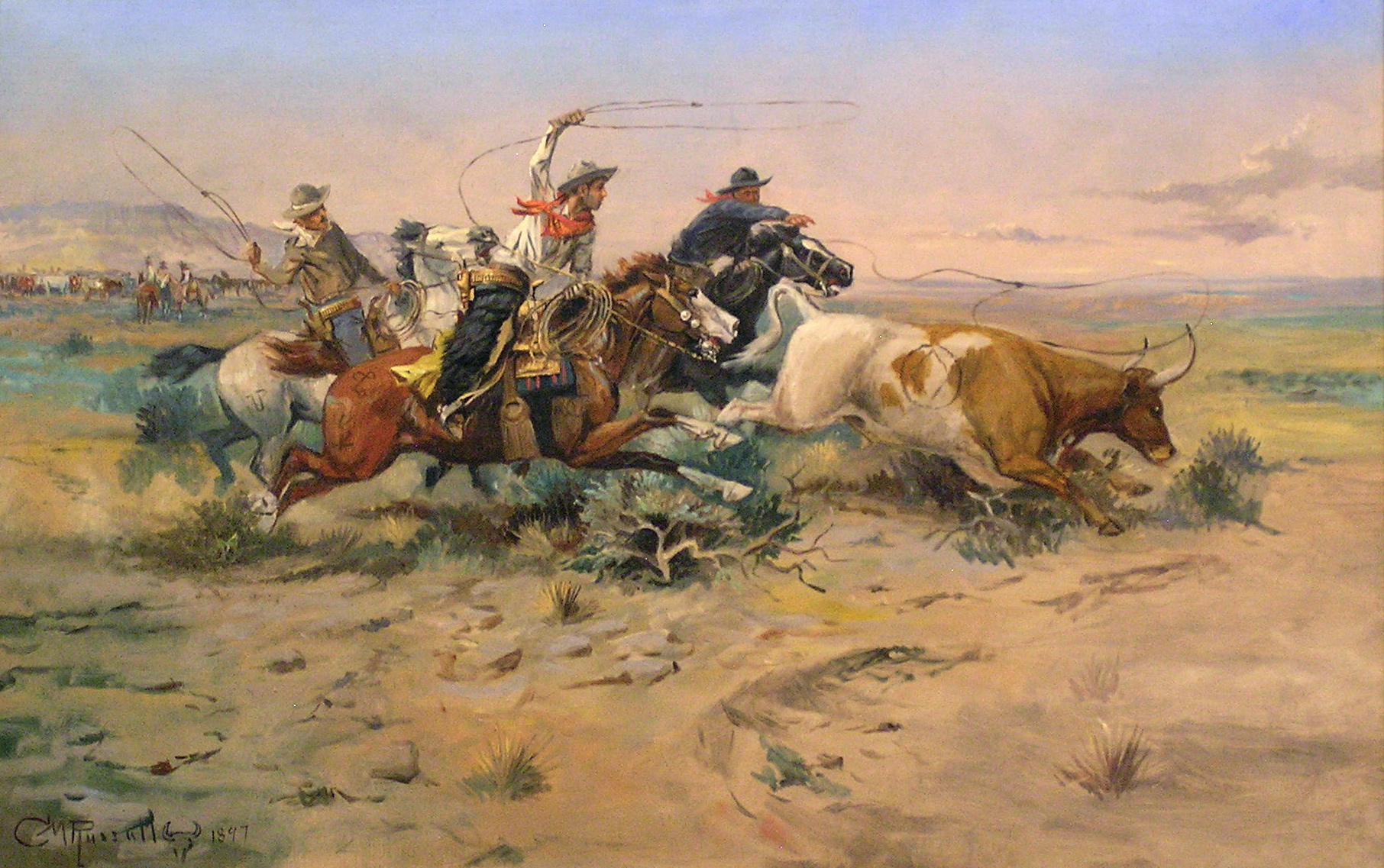|
Bosal
A bosal (, , or ) is a type of noseband used on the classic hackamore of the ''vaquero'' tradition. It is usually made of braided rawhide (textile), rawhide and is fitted to the horse in a manner that allows it to rest quietly until the rider uses the reins to give a signal. It acts upon the horse's nose and jaw. Though seen in both the "Texas" and the "California" cowboy traditions, it is most closely associated with the "California" style of western riding.Price, Steven D. (ed.) ''The Whole Horse Catalog: Revised and Updated'' New York:Fireside 1998 p. 158-159 Sometimes the term ''bosal'' is used to describe the entire classic hackamore or ''jaquima.'' Technically, however, the term refers only to the noseband portion of the equipment. Bosals come in varying diameters and weights, allowing a more skilled horse to "graduate" into ever lighter equipment. Once a young horse is solidly trained with a bosal, a bit (horse), bit is added and the horse is gradually shifted from ... [...More Info...] [...Related Items...] OR: [Wikipedia] [Google] [Baidu] |
Hackamore
A hackamore (or ) is a type of animal headgear which does not have a bit. Instead, it has a special type of noseband that works on pressure points on the face, nose, and chin. Hackamores are most often seen in western riding and other styles of riding derived from Spanish traditions, and are occasionally seen in some English riding disciplines such as show jumping and the stadium phase of eventing. Various hackamore designs are also popular for endurance riding. While usually used to start young horses, they are often seen on mature horses with dental issues that make bit use painful, and on horses with mouth or tongue injuries that would be aggravated by a bit. Some riders also like to use them in the winter to avoid putting a frozen metal bit into a horse's mouth. There are many styles, but the classic hackamore design features a ''bosal'' () noseband, and sometimes itself called a "bosal" or a "bosal hackamore". It has a long rope rein called a mecate and may al ... [...More Info...] [...Related Items...] OR: [Wikipedia] [Google] [Baidu] |
Fiador (tack)
A fiador () term of Spanish colonial origin referring to a hackamore component used principally in the Americas. In English-speaking North America, the fiador is known principally as a type of throatlatch used on the bosal-style hackamore. Its purpose is to stabilize a heavy noseband or bosal and prevent the bridle from shifting. It is not used for tying the horse. A fiador-like design and fiador knot is also used under the jaw on some rope halters, usually ending in a loop to which a lead rope can be attached. This, however, is not an independent "fiador", nor generally labeled as such; it is simply an integral part of the halter itself. Origins The origin of the word ''fiador'' in its equestrian sense is obscure but appears to be of Mexican or South American origin. In Spanish, the word ''fiador'' has numerous senses, all related to safekeeping. For example, an 18th-century Spanish—English dictionary defines ''fiador'' as ''surety, bail; he that is bound for another. ... [...More Info...] [...Related Items...] OR: [Wikipedia] [Google] [Baidu] |
Mecate (rein)
The mecate ( or less anglicized ; ) is the rein system of the bosal style hackamore used to train young horses. It is a long rope, traditionally of horsehair, approximately 20–25 feet long and up to about 3/4 inch in diameter. It is tied to the bosal in a specialized manner that adjusts the fit of the bosal around the muzzle of the horse, and creates both a looped rein and a long free end that can be used for a number of purposes. When a rider is mounted, the free end is coiled and attached to the saddle. When the rider dismounts, the lead rein is not used to tie the horse to a solid object, but rather is used as a lead rope and a form of Longe line when needed.Price, 158 The traditional mecate was an integral part of the ''vaquero'' culture that became the California tradition of western riding. The classic mecate is hand-braided of horsehair, usually long hair from the tail, often a blend of black and white hairs made into an alternating design. Modern mecates are made n ... [...More Info...] [...Related Items...] OR: [Wikipedia] [Google] [Baidu] |
Spade Bit (horse)
The spade bit is a historic vaquero design for a type of curb bit with straight, highly decorated shanks and a mouthpiece that includes a straight bar, a narrow port with a cricket, and a "spoon," a flat, partly rounded plate affixed above the port, supported by braces on either side. Considered a highly technical piece of equipment to be used only on a finished horse, the spade bit is a refined tool that experts compare to driving a sports car in its ability to convey precise commands to the horse. Not all horses have the conformation or temperament to become a finished spade bit horse, a process that takes a number of years and is seldom complete until a horse has at least five years of training under saddle. Use The spade bit is an elaborate, complex bit that can only be properly used on a highly trained horse handled by a skilled rider. In the ''vaquero'' tradition, its use represents the highest level of trust and communication between horse and rider. Experts compare the ... [...More Info...] [...Related Items...] OR: [Wikipedia] [Google] [Baidu] |
Bridle
A bridle is a piece of equipment used to direct a horse. As defined in the ''Oxford English Dictionary'', the "bridle" includes both the that holds a bit that goes in the mouth of a horse, and the reins that are attached to the bit. It provides additional control and communication through rein pressure (Oxford English Dictionary, n.d., para. 1). Headgear without a bit that uses a noseband to control a horse is called a hackamore, or, in some areas, a bitless bridle. There are many different designs with many different name variations, but all use a noseband that is designed to exert pressure on sensitive areas of the animal's face to provide direction and control. The bridle was devised by Indo-European herders of the Pontic-Caspian steppes to control horses between 3000 BC and 2000 BC. Parts The bridle consists of the following elements: * Crownpiece: The crownpiece, headstall (US) or headpiece (UK) goes over the horse's head just behind the animal's ears, at the pol ... [...More Info...] [...Related Items...] OR: [Wikipedia] [Google] [Baidu] |
Noseband
A noseband is the part of a horse's bridle that encircles the nose and jaw of the horse. In English riding, where the noseband is separately attached to its own headstall or crownpiece, held independently of the bit, it is often called a cavesson or caveson noseband. In other styles of riding, a simple noseband is sometimes attached directly to the same headstall as the bit. Development A noseband may have been one of the first tools used by humans to domesticate and ride horses. The bit developed later. The noseband was originally made of leather or rope. After the invention of the bit, the noseband was, in some cultures, demoted to a halter worn beneath the bridle that allowed the rider to remove the bit from the horse's mouth after work and leave a restraining halter on underneath, or to tie the horse by this halter, instead of by the bit, which could result in damage to the horse's mouth if it panicked. However, its ability to hold a horse's mouth shut over the bit was ... [...More Info...] [...Related Items...] OR: [Wikipedia] [Google] [Baidu] |
Bridle
A bridle is a piece of equipment used to direct a horse. As defined in the ''Oxford English Dictionary'', the "bridle" includes both the that holds a bit that goes in the mouth of a horse, and the reins that are attached to the bit. It provides additional control and communication through rein pressure (Oxford English Dictionary, n.d., para. 1). Headgear without a bit that uses a noseband to control a horse is called a hackamore, or, in some areas, a bitless bridle. There are many different designs with many different name variations, but all use a noseband that is designed to exert pressure on sensitive areas of the animal's face to provide direction and control. The bridle was devised by Indo-European herders of the Pontic-Caspian steppes to control horses between 3000 BC and 2000 BC. Parts The bridle consists of the following elements: * Crownpiece: The crownpiece, headstall (US) or headpiece (UK) goes over the horse's head just behind the animal's ears, at the pol ... [...More Info...] [...Related Items...] OR: [Wikipedia] [Google] [Baidu] |
Vaquero
The ''vaquero'' (; , ) is a horse-mounted livestock herder of a tradition that has its roots in the Iberian Peninsula and extensively developed in what what is today Mexico (then New Spain) and Spanish Florida from a method brought to the Americas from Spain. The vaquero became the foundation for the North American cowboy, in Northern Mexico, Southwestern United States, Florida and Western Canada. The cowboys of the Great Basin still use the term " buckaroo", which may be a corruption of ''vaquero'', to describe themselves and their tradition. Many in Llano Estacado and along the southern Rio Grande prefer the term ''vaquero'', while the indigenous and Hispanic communities in the age-old ''Nuevo México'' and New Mexico Territory regions use the term ''caballero''. ''Vaquero'' heritage remains in the culture of Mexico (Especially in Northern Mexico), along with the Californio (California), Neomexicano (New Mexico), Tejano (Texas), Central, and South America, as well as other ... [...More Info...] [...Related Items...] OR: [Wikipedia] [Google] [Baidu] |
Western Riding
Western riding is considered a style of horse riding which has evolved from the ranching and welfare traditions which were brought to the Americas by the Spanish conquistadors, as well as both equipment and riding style which evolved to meet the working needs of the cowboy in the American West. At the time, American cowboys had to work long hours in the saddle and often over rough terrain, sometimes having to rope a cattle using a lariat, also known as a lasso. Because of the necessity to control the horse with one hand and use a lariat with the other, western horses were trained to neck rein, that is, to change direction with light pressure of a rein against the horse's neck. Horses were also trained to exercise a certain degree of independence in using their natural instincts to follow the movements of a cow, thus a riding style developed that emphasized a deep, secure seat, and training methods encouraged a horse to be responsive on very light rein contact. There are signific ... [...More Info...] [...Related Items...] OR: [Wikipedia] [Google] [Baidu] |
Cowboy
A cowboy is an animal herder who tends cattle on ranches in North America, traditionally on horseback, and often performs a multitude of other ranch-related tasks. The historic American cowboy of the late 19th century arose from the ''vaquero'' traditions of northern Mexico and became a figure of special significance and legend.Malone, J., p. 1. A subtype, called a Wrangler (profession), wrangler, specifically tends the horses used to work cattle. In addition to ranch work, some cowboys work for or participate in rodeos. Cowgirls, first defined as such in the late 19th century, had a less-well documented historical role, but in the modern world work at identical tasks and have obtained considerable respect for their achievements. Cattle handlers in many other parts of the world, particularly South America and Australia, perform work similar to the cowboy. The cowboy has deep historic roots tracing back to Spain and the earliest European Settlement of the Americas, settlers of th ... [...More Info...] [...Related Items...] OR: [Wikipedia] [Google] [Baidu] |
Rein
Reins are used to direct a horse (or other animal) when riding or driving. They are attached to a bridle's bit or noseband and are made of leather, nylon, or other materials. Reins are used to give subtle commands or cues—also known as rein aids—to ask for a turn, a slower speed, a halt, or to go backwards. Types Other uses The word "rein" is sometimes used incorrectly to refer to a lead rope or a longe line, neither of which are reins. The idiom " rein in" means to hold back, slow down, control or limit; often misspelled as " reign in". The idiom " free rein" means to give or allow complete freedom, in action and decision, over something. See also *Horse tack * Neck rein *Riding aids Riding aids are the cues a rider gives to a horse to communicate what they want the animal to do. Riding aids are broken into the ''natural aids'' and the ''artificial aids''. Natural aids ''Natural aids'' are those of the rider's body, a ... [...More Info...] [...Related Items...] OR: [Wikipedia] [Google] [Baidu] |









